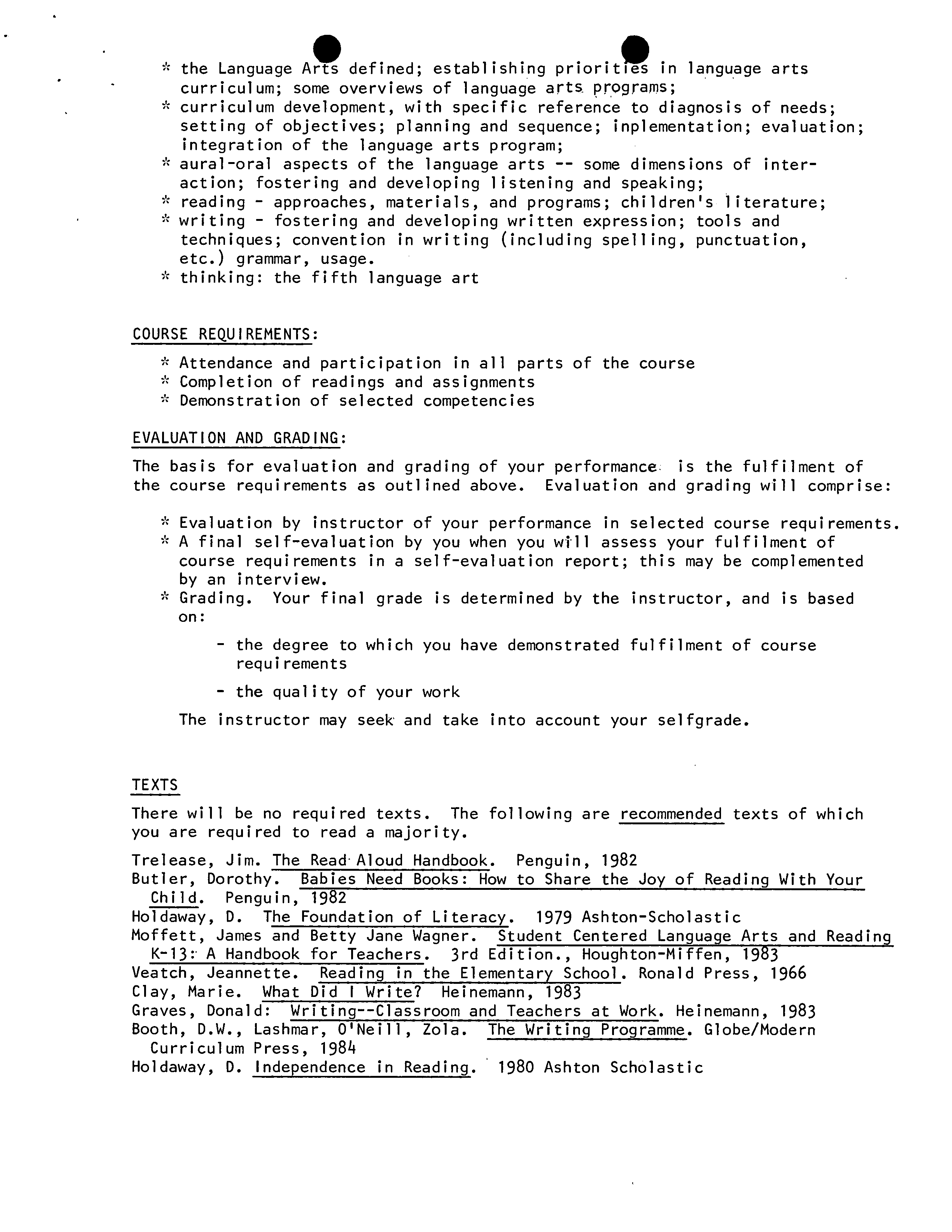.
?
S
Education
472-4
Design for Learning: English and Language Arts
ELEMENTARY
SPRING 1985
?
INSTRUCTOR: Prof. Meguido Zola
Mondays
4:30 -
8.20 p.m. ?
LOCATION: ?
MPX
7610
Music Room
CALENDAR DESCRIPTION
This course is offered to students and practicing teachers who wish to explore
that language communication-based approach to learning called the Language
Arts.
The course is designed to introduce you to planning for learning, creating
learning environments, and developing strategies, techniques, and materials
in the Language Arts in the elementary school.
COURSE OBJECTIVES
The overarching objective of this course is to increase your understanding of
concepts, principles and theory underpinning language learning; to give you
opportunities to examine and reflect upon your beliefs regarding learning and
teaching the language arts; to enable you toreflecton your classroom experience
and plan ways in which you may test and try new ideas in the future; to assist
you to develop a new repertoire of methods and materials that will enhance
language learning in the classroom.
To these global ends we shall focus on the language arts as a broad curriculum
involving the integration of all subject areas as well as on the various
elements of the language arts -- thinking, listening and speaking, reading,
writing -- and on how better to present them to children and to involve
children with them.
The course will assume/expect throughout, a child-centered, creative, indiv-
idualistic approach to the structuring oflearning environments and experiences.
We will emphasize an approach which taps the inner life of the child and uses
that as working material to promote cognitive awareness, more sophisticated
and aesthetic language usage, and increased skills in interpersonal communication.
The course will comprise a broad range of experiences: e.g.,lèctures; workshops
and demonstrations; seminars; small-group work; field experience, etc. These
experiences will be organized in such a way as to model a student-centered
approach and maximize individualization of learning.
There will be, within the course itself, numerous opportunities for you to
pursue interests of youi- own in developing teaching methods and materials
related to instruction the language arts. But there will additionally be
activities that all will pursue, with some of these to be shared among members
of the class.
OUTLINE OF TOPICS
Some of the topics which may be explored, according to group interest and need,
include:
the Language Arts defined; establishing priorities in language arts
curriculum; some overviews of language arts programs;
curriculum development, with specific reference to diagnosis of needs;
setting of objectives; planning and sequence; inpiementation; evaluation;
integration of the language arts program;
* aural-oral aspects of the language arts -- some dimensions of inter-
action; fostering and developing listening and speaking;
* reading - approaches, materials, and programs; children's literature;
* writing - fostering and developing written expression; tools and
techniques; convention in writing (including spelling, punctuation,
etc.) grammar, usage.
thinking: the fifth language art
COURSE REQUIREMENTS:
• Attendance and participation in all parts of the course
• Completion of readings and assignments
• Demonstration of selected competencies
EVALUATION AND GRADING:
The basis for evaluation and grading of your performance is the fulfilment of
the course requirements as outlined above. Evaluation and grading will comprise:
* Evaluation by instructor of your performance in selected course requirements.
A final self-evaluation by you when you will assess your fulfilment of
course requirements in a self-evaluation report; this may be complemented
by an interview.
Grading. Your final grade is determined by the instructor, and is based
on:
- the degree to which you have demonstrated fulfilment of course
requirements
- the quality of your work
The instructor may seek and take into account your selfgrade.
TEXTS
There will be no required texts. The following are recommended texts of which
you are required to read a majority.
Trelease, Jim. The Read Aloud Handbook. Penguin, 1982
Butler, Dorothy. Babies Need Books: How to Share the Joy of Reading With Your
Child. Penguin, 1982
Holdaway, D. The Foundation of Literacy. 1979 Ashton-Scholastic
Moffett, James and Betty Jane Wagner. Student Centered Language Arts and Reading
K-13: A Handbook for Teachers. 3rd Edition., Houghton-Miffen, 1983
Veatch, Jeannette. Reading in the Elementary School. Ronald Press, 1966
Clay, Marie. What Did I Write? Heinemann, 1983
Graves, Donald: Writing--Classroom and Teachers at Work. Heinemann, 1983
Booth, D.W., Lashmar, O'Neill, Zola. The Writing Programme. Globe/Modern
Curriculum Press, 19814
Holdaway, D. Independence in Reading. 1980 Ashton Scholastic


